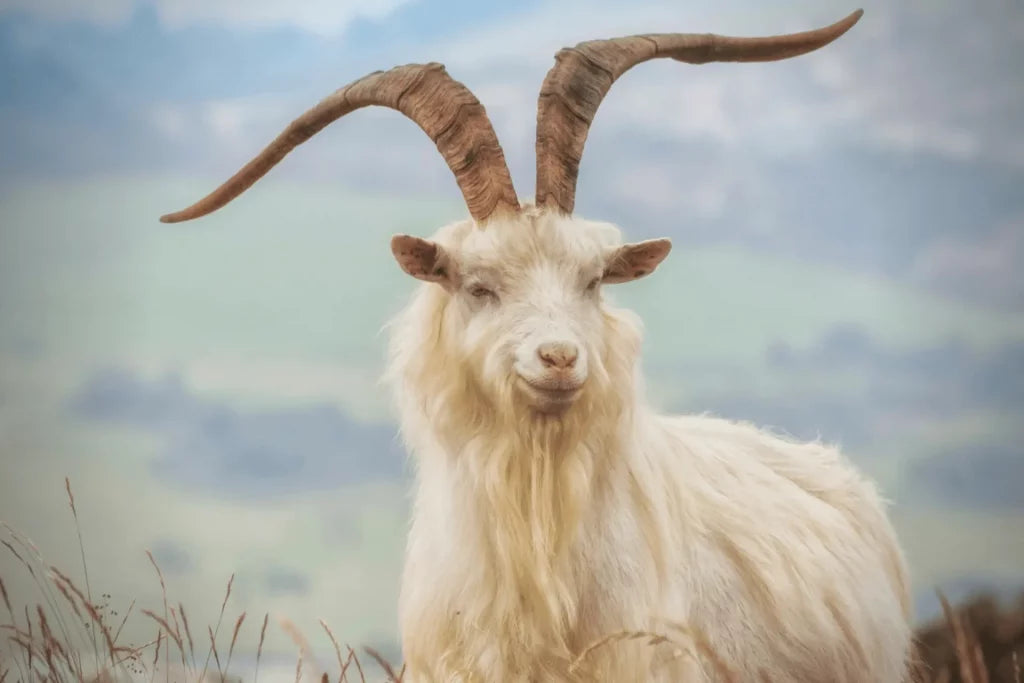
Where is Pahsmina Goat found?
Share
The Pashmina Goat is a breed of domestic goat known for its fine, soft undercoat which is used to produce high-quality Pashmina wool. Pashmina wool is highly valued in the textile industry due to its luxurious texture and warmth. This breed of goat is primarily found in the high altitude regions of India, Nepal, Pakistan, and China. The Pashmina Goat has been an important part of the textile industry for centuries, and its wool is considered to be one of the finest natural fibers in the world. The purpose of this blog is to provide an overview of where the Pashmina Goat is found, its importance in the textile industry, and the challenges it faces today. Additionally, the blog aims to raise awareness about the need for conservation and sustainable use of this valuable breed of goat.
Overview of Pashmina Goat

The Pashmina Goat is believed to have originated in the high altitude regions of the Himalayas, where it has been bred for centuries for its soft and warm undercoat. The goats are typically small to medium-sized, with a height of around 65-70cm and a weight of 35-45kg. They have a long, thin neck and a narrow, wedge-shaped head. Their ears are pendulous and pointed, while their eyes are large and expressive. Pashmina Goats have a fine and soft undercoat, which is composed of long, thin fibers that are less than 19 microns in diameter. This undercoat provides insulation against the cold, making it ideal for producing high-quality wool. The outer coat of the Pashmina Goat is coarser and longer, providing protection against harsh weather conditions. The breed comes in a range of colors, including white, grey, and brown. Due to its high-quality wool, the Pashmina Goat has been highly valued for centuries and is an important part of the cultural and economic heritage of the regions where it is found.
Also read: How can you tell if Cashmere is Real
Habitat and Geographical Distribution of Pashmina Goat
The Pashmina Goat is believed to have originated in the high altitude regions of the Himalayas, where it has been bred for centuries for its soft and warm undercoat. The goats are typically small to medium-sized, with a height of around 65-70cm and a weight of 35-45kg. They have a long, thin neck and a narrow, wedge-shaped head. Their ears are pendulous and pointed, while their eyes are large and expressive. Pashmina Goats have a fine and soft undercoat, which is composed of long, thin fibers that are less than 19 microns in diameter. This undercoat provides insulation against the cold, making it ideal for producing high-quality wool. The outer coat of the Pashmina Goat is coarser and longer, providing protection against harsh weather conditions. The breed comes in a range of colors, including white, grey, and brown. Due to its high-quality wool, the Pashmina Goat has been highly valued for centuries and is an important part of the cultural and economic heritage of the regions where it is found.

The Pashmina Goat is primarily found in the high altitude regions of the Himalayas, which includes parts of India, Nepal, Pakistan, and China. These regions are characterized by extreme climatic conditions and difficult terrain, making it a challenging environment for both humans and animals. The goats are generally raised in semi-nomadic herds by local communities, who rely on them for their livelihoods.
The climate and topography of the regions where the Pashmina Goat is found can be extreme, with cold temperatures, high winds, and heavy snowfall. The goats have adapted to these harsh conditions by developing a thick, warm undercoat that provides insulation against the cold. The terrain is also challenging, with steep mountains and rocky terrain. This can make it difficult for the goats to find adequate food and water, and they must be able to navigate this terrain to survive.
The Pashmina Goat is found primarily in India. In India, the goats are found in the high altitude regions of Jammu and Kashmir, the goats are found in the high altitude regions of the Himalayas, including the Mustang and Dolpo regions. In Pakistan, the goats are found in the northern region of Azad Jammu and Kashmir. These regions are known for their high-quality Pashmina wool, which is used to produce luxury textiles and clothing. However, the Pashmina Goat is facing various threats, including poaching, climate change, and habitat loss, which are affecting its distribution and survival.
Also read: Is Pashmina and Cashmere the Same
IV. Pashmina Goat in India

The Pashmina Goat is an important breed of domestic goat in India, primarily found in the high altitude regions of Jammu and Kashmir, Himachal Pradesh, and Uttarakhand. The breed is highly valued for its fine, soft undercoat, which is used to produce high-quality Pashmina wool. Pashmina wool has been an important part of the textile industry in India for centuries, and is used to produce a range of luxury textiles and clothing.
In India, the major regions where the Pashmina Goat is found include the Changthang region of Ladakh, the Pir Panjal range of Jammu and Kashmir. The region is known for its harsh climatic conditions and difficult terrain, and the goats have adapted to these conditions over centuries. The goats are generally raised by local communities in semi-nomadic herds, and are an important part of the local economy.
However, Pashmina Goat farmers in India are facing a range of challenges that are affecting the survival of the breed. One of the major challenges is climate change, which is leading to changes in weather patterns and affecting the availability of food and water for the goats. Another challenge is habitat loss, as increasing human activities are encroaching on the natural habitat of the goats. Additionally, poaching is a major threat to the Pashmina Goat, as the demand for its wool has led to illegal hunting and trade. These challenges are affecting the distribution and survival of the breed, and efforts are needed to conserve and protect this valuable breed of goat.
Also read: Which is the most expensive wool in the World
Threat to Pashmina Goat

The Pashmina Goat is facing a range of threats that are affecting its survival and distribution. One of the major threats is poaching and illegal trade of the Pashmina Goat. The high demand for Pashmina wool has led to illegal hunting and trade of the goat, which is causing a decline in its population. Despite the strict laws in place to protect the goat, poaching continues to be a major challenge, and efforts are needed to strengthen enforcement and raise awareness about the issue.
Climate change is another major threat to the Pashmina Goat. The changing weather patterns and increasing temperatures are affecting the availability of food and water for the goats, and are leading to changes in their behavior and migration patterns. The goats are also facing new diseases and parasites as a result of the changing climate, which is affecting their health and well-being.
Lack of awareness and conservation efforts is also a major threat to the Pashmina Goat. Many people are not aware of the importance of the breed and its role in the textile industry, and there is a lack of concerted efforts to conserve and protect the breed. This is leading to a decline in the population of the goat, and is affecting the livelihoods of the communities that rely on the goat for their livelihoods. Efforts are needed to raise awareness about the importance of the Pashmina Goat and to implement conservation measures to protect the breed and its habitat.
Conclusion
In conclusion, the Pashmina Goat is an important breed of domestic goat that plays a significant role in the textile industry, particularly in India. The breed is known for its fine, soft undercoat, which is used to produce high-quality Pashmina wool. However, the Pashmina Goat is facing a range of threats, including poaching, climate change, and lack of conservation efforts. It is important to raise awareness about the importance of the breed and to implement conservation measures to protect the breed and its habitat. Sustainable use of the Pashmina Goat can also help to ensure its survival while providing economic benefits to the communities that rely on it. Readers are encouraged to support conservation efforts and to promote sustainable use of the Pashmina Goat for the benefit of current and future generations.




